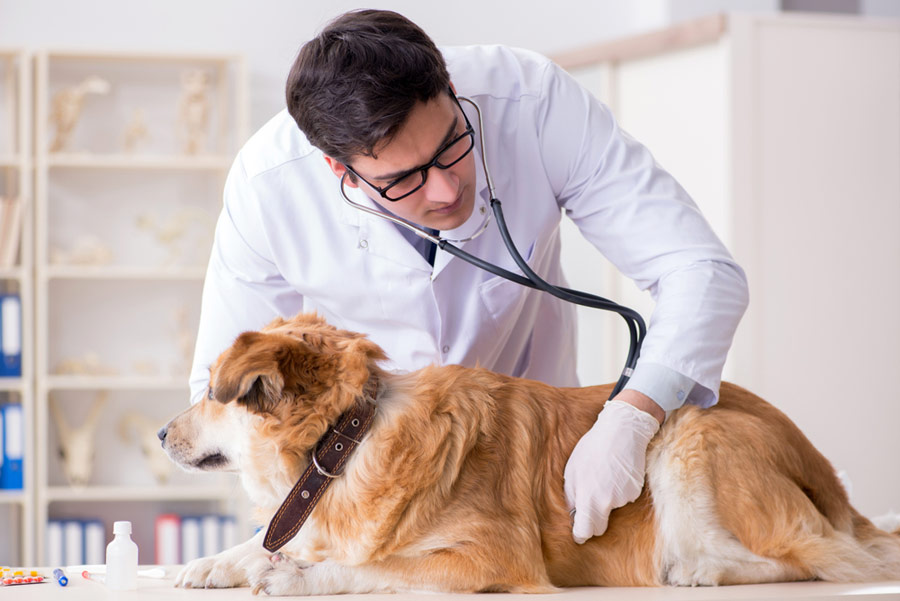It’s fairly common for dogs to develop a fear of going to the vets. After all, when visiting the vet they encounter many strange sights, sounds and smells.
Certainly, a trip to the vet may result in an injection. It may involve being poked and prodded by a stranger, as well as a general feeling of unease. However, when a dog becomes restless, anxious or afraid they can act out of character. This may lead to aggressive behaviour, such as snarling, biting or scratching, which could result in human or canine injury.
So how do you avoid injury and distress as a result of veterinary fear? The key is to recognise when a dog is feeling frightened and have a few tricks up your sleeve to ease that fear.
Veterinary fear — know the signs
Indeed, the majority of dogs that become aggressive on entering the veterinary clinic are displaying signs of fear-associated aggression. To prevent acts of aggression you must first address the feelings of fear.
Signs of fear may begin before the dog even enters the vets. For example, some dogs will be afraid of the car because the only time they ever go on a car journey is when they’re taking a trip to the vets.
Vets, as well as other pet professionals, can raise awareness of this issue with pet owners. As a vet, if your client brings their puppy in for his or her vaccinations or a simple check-up, ask if this is the first time the dog has been in the car.
By discussing the fact that many dogs develop a fear of the car because of its association with the vets, owners can take action to help alleviate this fear.
Other signs of fear include:
- Panting
- Drooling
- Pacing
- Shaking
- Avoidance (hiding behind the owner, or under furniture)
- Whining
- Growling
- Biting or snapping
- Urination
Preventing veterinary fear
When it comes to addressing a dog’s fear of the vets there are two approaches—prevention and treatment. Of course, prevention is always the preferred action, but it will take proactive action by you, the professional, and the owner.
Here are a few ways to assist owners to dissuade their pooch from fearing the vets
Encourage owners to check their dog’s health at home
Sure, your client might respond with, “but that’s what you do!” Nonetheless, you can advise that by regularly checking over their pet they will help their dog to become familiar with veterinary handling.
They can start by simply spending time throughout the course of the week restraining their dog and checking his or her teeth. They can hold the dog and check behind its ears, all the while giving praise.
These small actions needn’t take long but, over time, they’ll help their dog become more familiar with the actions of the vet.
Suggest a home visit on occasion
Try mixing things up a bit and visiting your clients at home. Having their veterinary check in the comfort of home may help ease a dog’s fears.
Plus, a little time away from the clinic might just do wonders for your stress levels too! After all, veterinary stress is highly prevalent and often goes untreated.
Invite clients to drop in your clinic socially
If every single time a dog visits the veterinary clinic he or she is examined by strangers and sees weird instruments, they’re going to develop a dislike of the situation.
To overcome this, why not open up your clinic on occasion and invite your clients in for a meet and greet or some sort of social get together. You can offer doggy treats, play calming music and ensure our four-legged pals get lots of friendly and loving petting.
The next time the dogs arrive in the car park of the veterinary clinic they might not feel so frightened to come in!
Treating veterinary fear
Unfortunately, in some cases, a dog’s fear will be deep-rooted and will remain in place despite all efforts to alleviate it. In this case, medication might be the best option. Anti-anxiety medicine or anxiety-reducing/calming supplements can help ease fear and bring about calm.
In other cases, a muzzle might be the best course of action. While this won’t reduce the dog’s fear, it will prevent an injury from occurring. However, if a client intends to use a muzzle on their dog, be sure to talk to them about positive ways to introduce the muzzle. The last thing you want is a dog that associates the muzzle with the vets. This will only serve to exacerbate their fear and anxiety.
Regular trips to the vet are important for dogs’ health and wellbeing. As such, it’s vital to identify signs of fear in dogs as early as possible and to take steps to rectify the issue.
Good communication between you and your client is essential, as it working together to help our furry pals feel safe and secure.
Image source: Sydney Vet Specialists
Latest posts by Liz Walden (see all)
- Pet health: Medicinal cannabis for pets - December 27, 2021
- What pet business insurance do I need? - November 17, 2021
- Pet sitters: how to take time off - November 15, 2021










Leave A Comment